1996 CHEVROLET SUBURBAN engine
[x] Cancel search: enginePage 6 of 486
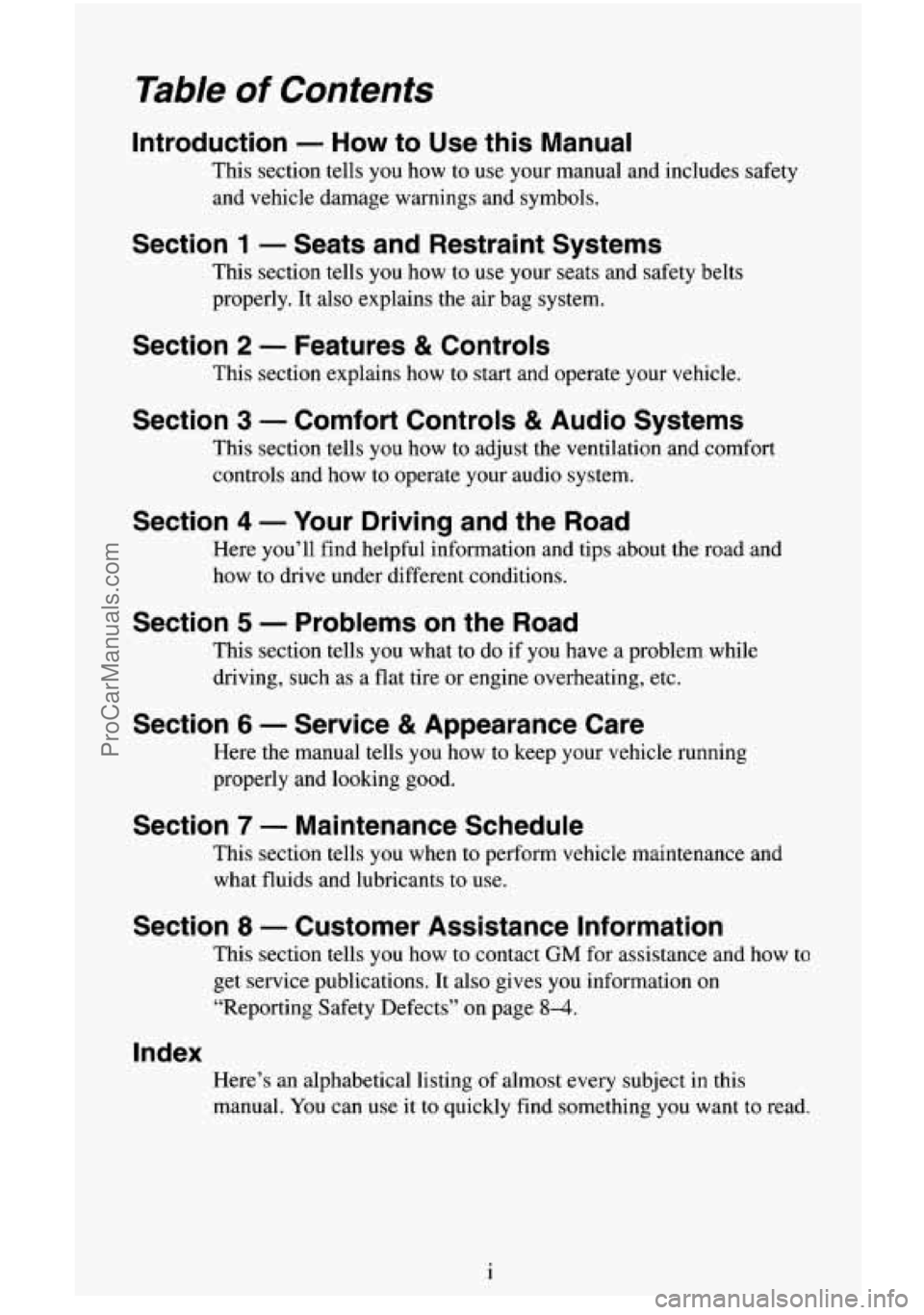
Table of Contents
Introduction - How to Use this Manual
This section tells you how to use your manual and includes safety
and vehicle damage warnings and symbols.
Section 1 - Seats and Restraint Systems
This section tells you how to use your seats and safety belts
properly. It also explains the air bag system.
Section 2 - Features & Controls
This section explains how to start and operate your vehicle.
Section 3 - Comfort Controls & Audio Systems
This section tells you how to adjust the ventilation and comfort
controls and how to operate your audio system.
Section 4 - Your Driving and the Road
Here you’ll find helpful information and tips about the road and
how to drive under different conditions.
Section 5 - Problems on the Road
This section tells you what to do if you have a problem while
driving, such as a flat tire or engine overheating, etc.
Section 6 - Service & Appearance Care
Here the manual tells you how to keep your vehicle running
properly and looking good.
Section 7 - Maintenance Schedule
This section tells you when to perform vehicle maintenance and
what fluids and lubricants to use.
Section 8 - Customer Assistance Information
This section tells you how to contact GM for assistance and how to
get service publications. It also gives you information on
“Reporting Safety Defects” on page
8-4.
Index
Here’s an alphabetical listing of almost every subject in this
manual. You can use it to quickly find something you want to read.
i
ProCarManuals.com
Page 13 of 486
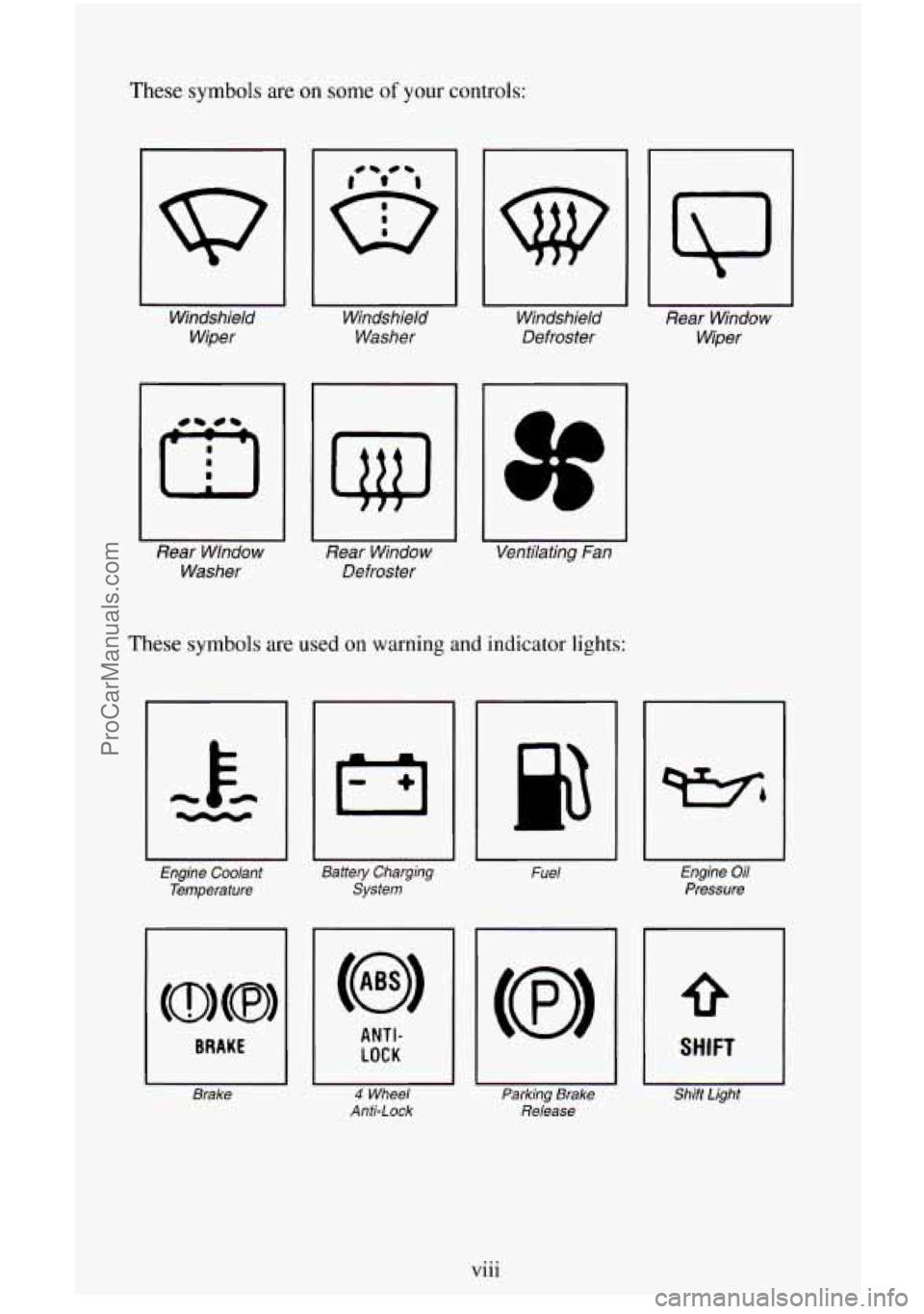
These symbols are on some of your controls:
I
Windshield
Wiper Windshield
Washer
Rear Wlndow Washer
I
Rear Window
Defroster
w
I
Windshield
Defroster
U
Ventilating Fan
These symbols are used on warning and indicator lights:
I -k 4cccy
Engine Coolant
Temperature
BRAKE
I Brake
I I
Battery Charging
System
ANTI-
I LOCK
I I 4 Wheel
Anti-Lock
Fuel
Parking Brake Release
I\J
Rear Window
Wiper
Engine Oil
Pressure
SHIFT
Shift Light
viii
. ~ .. ProCarManuals.com
Page 71 of 486
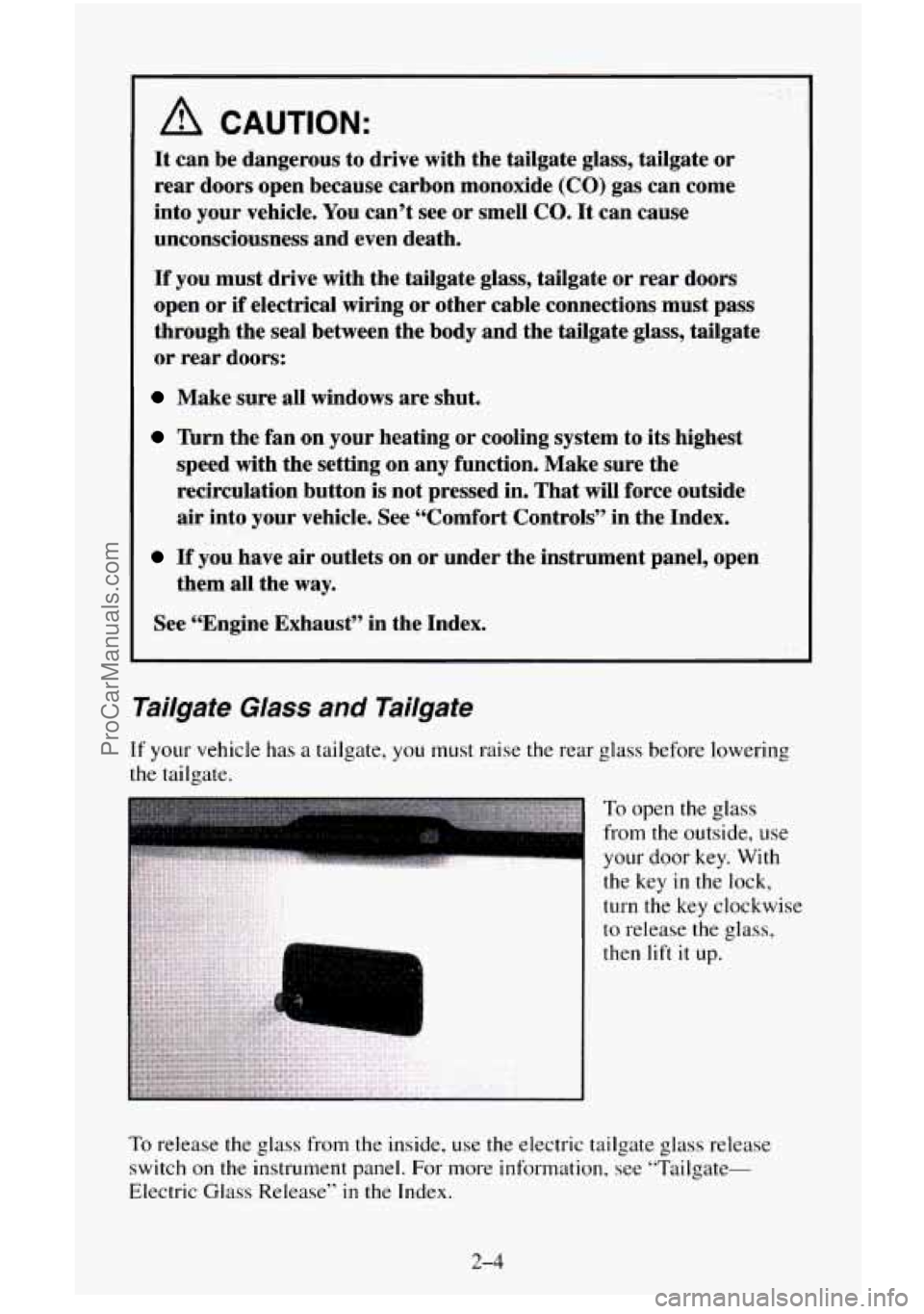
A CAUTION:
It can be dangerous to drive with the tailgate glass, tailgate or
rear doors open because carbon monoxide (CO) gas can come
into your vehicle. You can’t see or smell
CO. It can cause
unconsciousness and even death.
If you must drive with the tailgate glass, tailgate or rear doors
open or
if electrical wiring or other cable connections must pass
through the seal between the body and the tailgate glass, tailgate
or rear doors:
Make sure all windows are shut.
Turn the fan on your heating or cooling system to its highest
speed with the setting on any function. Make sure the
recirculation button is not pressed in. That will force outside
air into your vehicle. See “Comfort Controls” in the Index.
If you have air outlets on or under the instrument panel, open
them all the
way.
See “Engine Exhaust” in the Index.
Tailgate Glass and Tailgate
If your vehicle has a tailgate, you must raise the rear glass before lowering
the tailgate.
.. . ...
To open the glass
from
the outside, use
your door key. With
the key
in the lock,
turn the key clockwise
I to release the glass,
then lift it up.
To release the glass from the inside, use the electric tailgate glass release
switch
on the instrument panel. For more information, see “Fdilgate-
Electric Glass Release”
in the Index.
2-4
ProCarManuals.com
Page 79 of 486
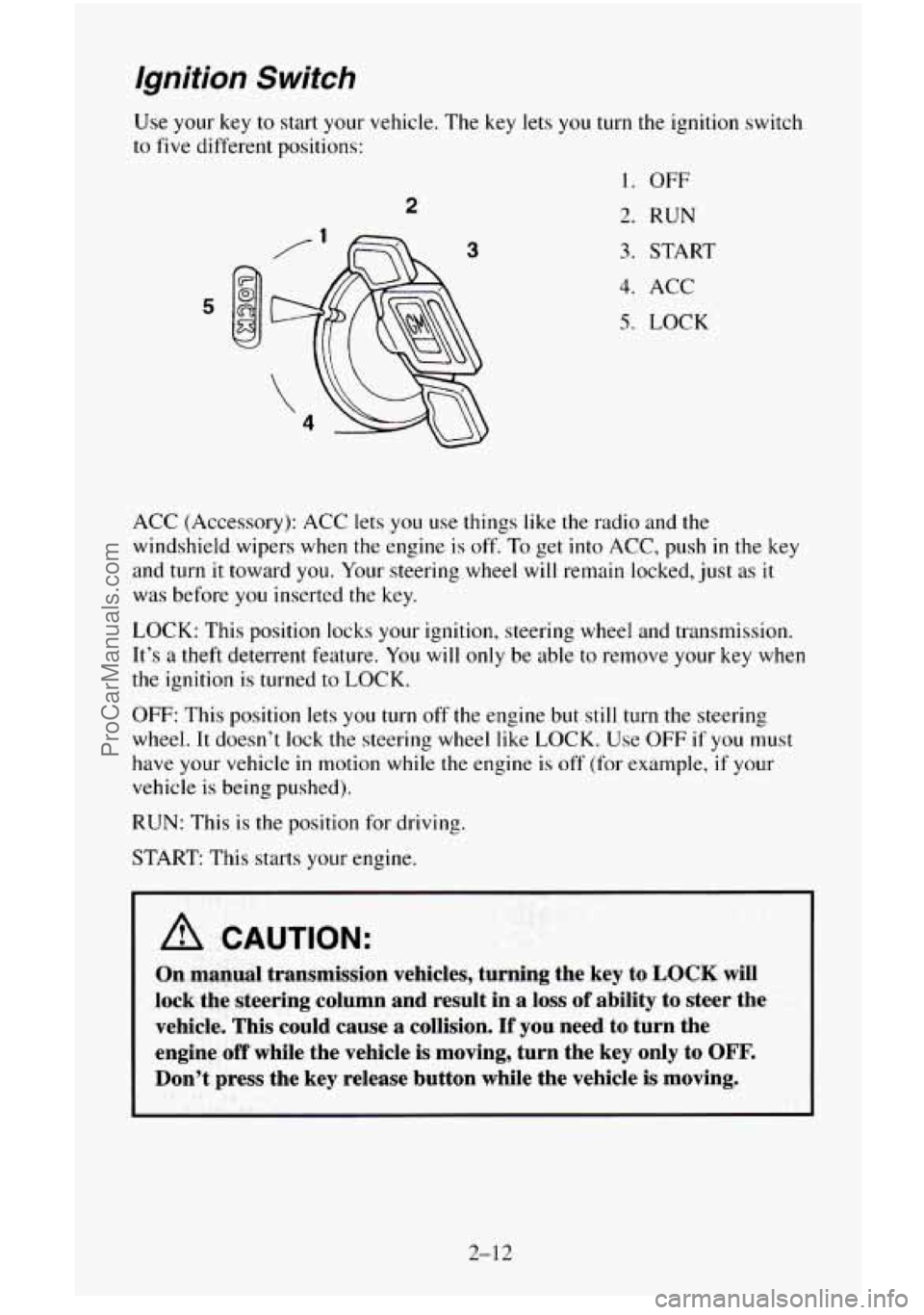
Ignition Switch
Use your key to start your vehicle. The key lets you turn the ignition switch
to
five different positions:
2
3
1. OFF
2. RUN
3. START
4. ACC
5. LOCK
ACC (Accessory): ACC lets you use things like the radio and the
windshield wipers when the engine is off. To get into ACC, push in the key
and turn it toward you. Your steering wheel will remain locked, just
as it
was before
you inserted the key.
LOCK: This position locks your ignition, steering wheel and transmission.
It’s a theft deterrent feature. You will only be able to remove your key when
the ignition is turned to LOCK.
OFF: This position lets you turn off the engine but still turn the steering
wheel.
It doesn’t lock the steering wheel like LOCK. Use OFF if you must
have your vehicle
in motion while the engine is off’ (for example, if your
vehicle is being pushed).
RUN: This is the position for driving.
START: This starts your engine.
I I
A CAUTION:
On manual transmission vehicles, turning the key to LOCK will
lock the steering column and result in
a loss of ability to steer the
vehicle. This could cause
a collision. If you need to turn the
engine
off while the vehicle is moving, turn the key only to OFF.
Don’t press the key release button while the vehicle is moving.
2-12
ProCarManuals.com
Page 80 of 486
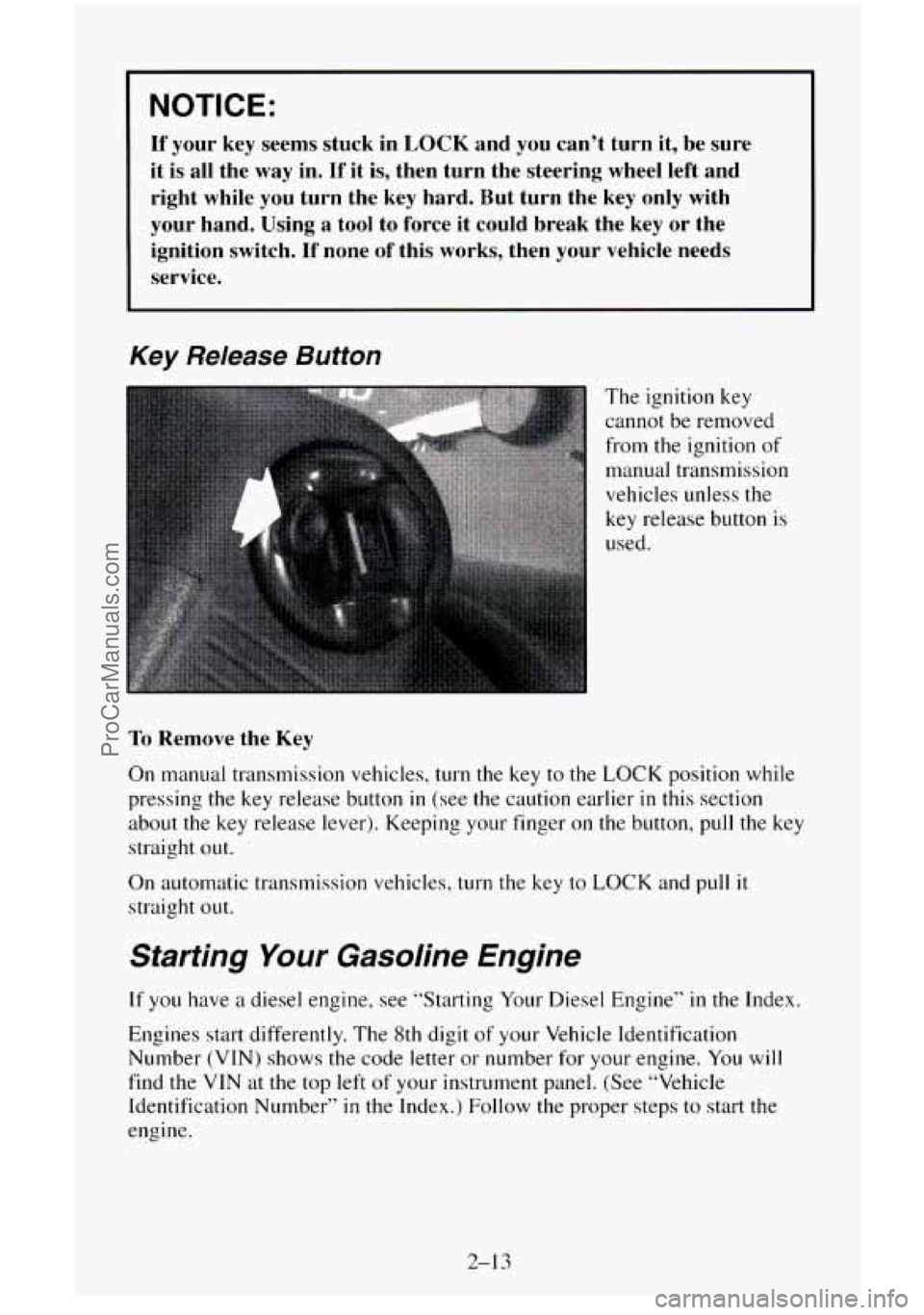
NOTICE:
If your key seems stuck in LOCK and you can’t turn it, be sure
it is all the
way in. If it is, then turn the steering wheel left and
right while you turn the key hard. But turn the key only with
your hand. Using
a tool to force it could break the key or the
ignition switch.
If none of this works, then your vehicle needs
service.
Key Release Button
The ignition key
cannot be removed
from the ignition of
manual transmission
vehicles unless the
key release button is
used.
To Remove the Key
On manual transmission vehicles, turn the key to the
LOCK position while
pressing the key release button
in (see the caution earlier in this section
about the key release lever). Keeping your finger
on the button, pull the key
straight
out.
On automatic transmission vehicles, turn the key to LOCK and pull it
straight out.
Starting Your Gasoline Engine
If you have a diesel engine, see “Starting Your Diesel Engine” in the Index.
Engines start differently. The 8th digit of your Vehicle Identification
Number
(VIN) shows the code letter or number for your engine. You will
find the
VIN at the top left of your instrument panel. (See “Vehicle
Identification Number”
in the Index.) Follow the proper steps to start the
engine.
2-13
ProCarManuals.com
Page 81 of 486
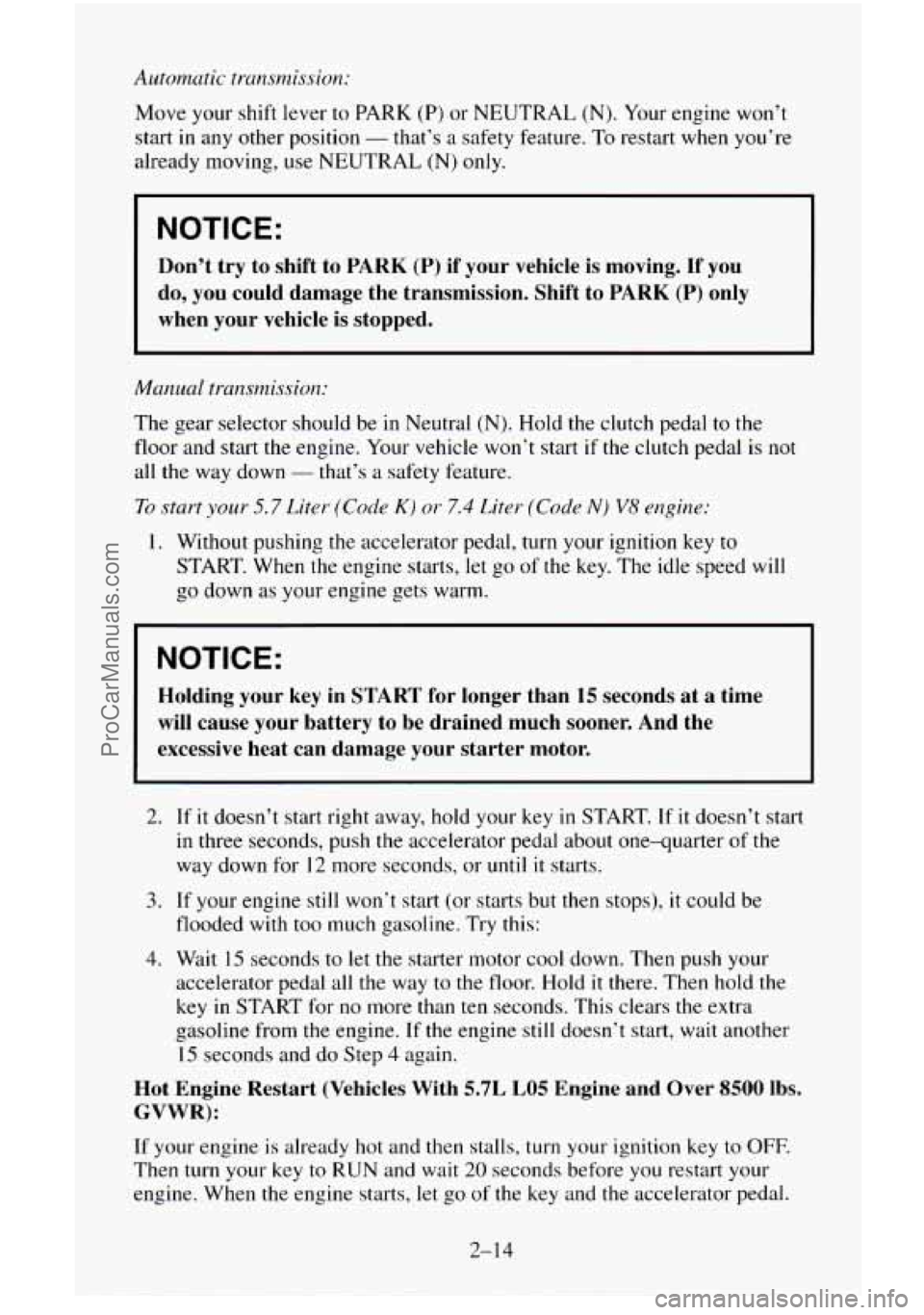
Automatic transrnissiox
Move your shift lever to PARK (P) or NEUTRAL (N). Your engine won’t
start in any other position
- that’s a safety feature. To restart when you’re
already moving, use NEUTRAL
(N) only.
NOTICE:
Don’t try to shift to PARK (P) if your vehicle is moving. If you
do, you could damage the transmission. Shift
to PARK (P) only
when your vehicle is stopped.
Manual transmission:
The gear selector should be in Neutral (N). Hold the clutch pedal to the
floor and start the engine. Your vehicle won’t start
if the clutch pedal is not
all the way down
- that’s a safety feature.
To start your 5.7 Liter (Code K) or 7.4 Liter (Code N) V8 engine:
1. Without pushing the accelerator pedal, turn your ignition key to
START. When the engine starts, let
go of the key. The idle speed will
go down
as your engine gets warm.
NOTICE:
Holding your key in START for longer than 15 seconds at a time
will cause your battery to be drained much sooner. And the
excessive heat can damage your starter motor.
2. If it doesn’t start right away, hold your key in START. If it doesn’t start
in three seconds, push the accelerator pedal about one-quarter of the
way down for 12 more seconds, or
until it starts.
flooded with too much gasoline. Try this:
3. If your engine still won’t start (or starts but then stops), it could be
4. Wait 15 seconds to let the starter motor cool down. Then push your
accelerator pedal all
the way to the floor. Hold it there. Then hold the
key in START for
no more than ten seconds. This clears the extra
gasoline from the engine. If the engine still doesn’t start, wait another
15 seconds and do Step 4 again.
Hot Engine Restart (Vehicles With 5.7L LO5 Engine and Over 8500 lbs.
GVWR):
If your engine is already hot and then stalls, turn your ignition key to OFF.
Then turn your key to RUN and wait 20 seconds before you restart your
engine. When the engine starts, let
go of the key and the accelerator pedal.
2-14
ProCarManuals.com
Page 82 of 486
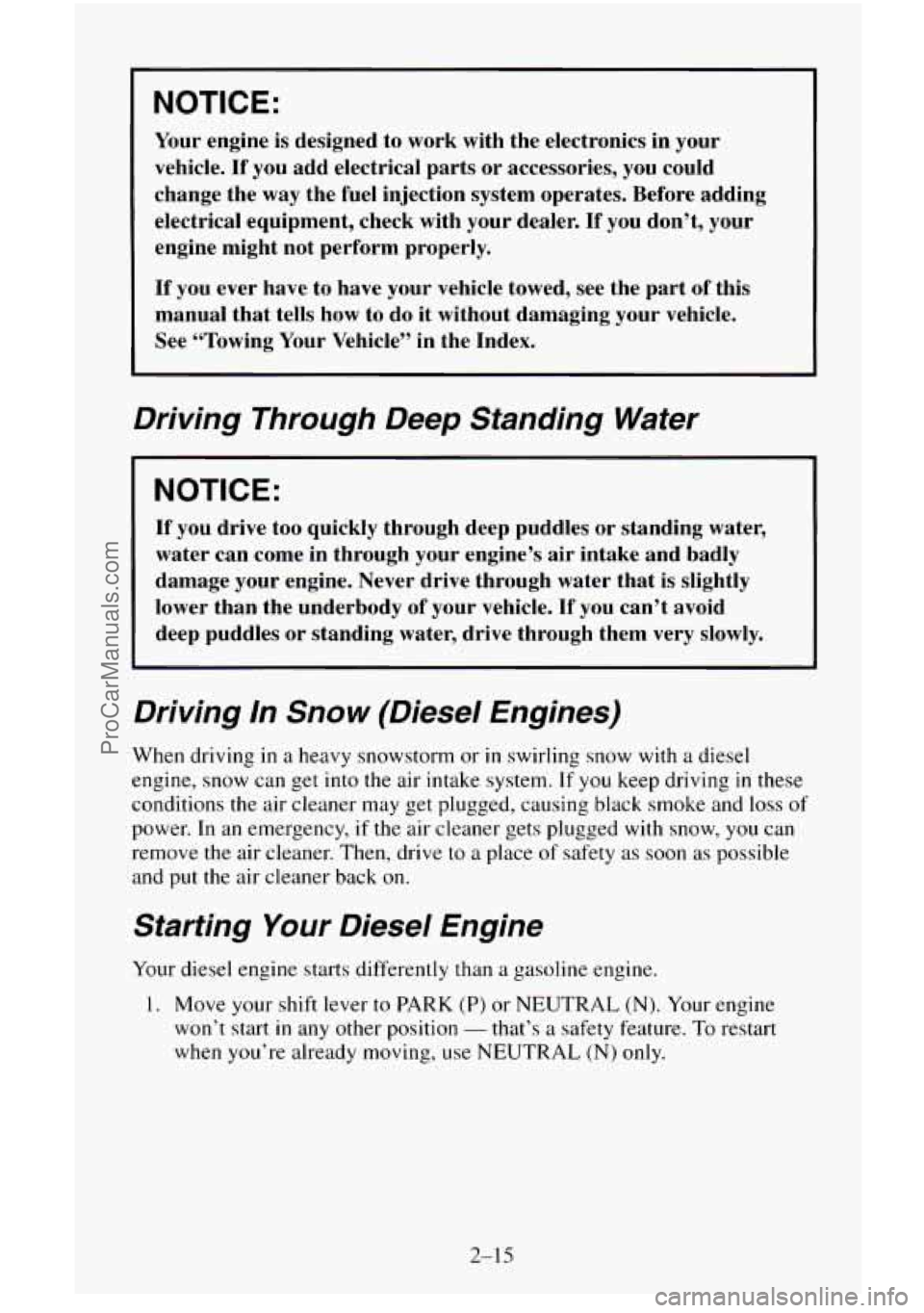
NOTICE:
Your engine is designed to work with the electronics in your
vehicle.
If you add electrical parts or accessories, you could
change the way the fuel injection system operates. Before addin\
g electrical equipment, check with your dealer.
If you don’t, your
engine might not perform properly.
If you ever have to have your vehicle towed, see the part of this
manual that tells how to do it without damaging your vehicle.
See “Towing Your Vehicle” in the Index.
Driving Through Deep Standing Water
NOTICE:
If you drive too quickly through deep puddles or standing water,
water can come in through your engine’s air intake and badl\
y
damage your engine. Never drive through water that is slightly \
lower than the underbody of your vehicle. If you can’t avoid
deep puddles
or standing water, drive through them very slowly.
Driving In Snow (Diesel Engines)
When driving in a heavy snowstorm or in swirling snow with a diesel
engine, snow can get into the air intake system.
If you keep driving in these
conditions the air cleaner may get plugged, causing black smoke and loss
of
power. In an emergency, if the air cleaner gets plugged with snow, you can
remove the air cleaner. Then, drive to
a place of safety as soon as possible
and put
the air cleaner back on.
Starting Your Diesel Engine
Your diesel engine starts differently than a gasoline engine.
1. Move your shift lever to PARK (P) or NEUTRAL (N). Your engine
won’t start
in any other position - that’s a safety feature. To restart
when you’re already moving, use NEUTRAL
(N) only.
2-1 5
ProCarManuals.com
Page 83 of 486
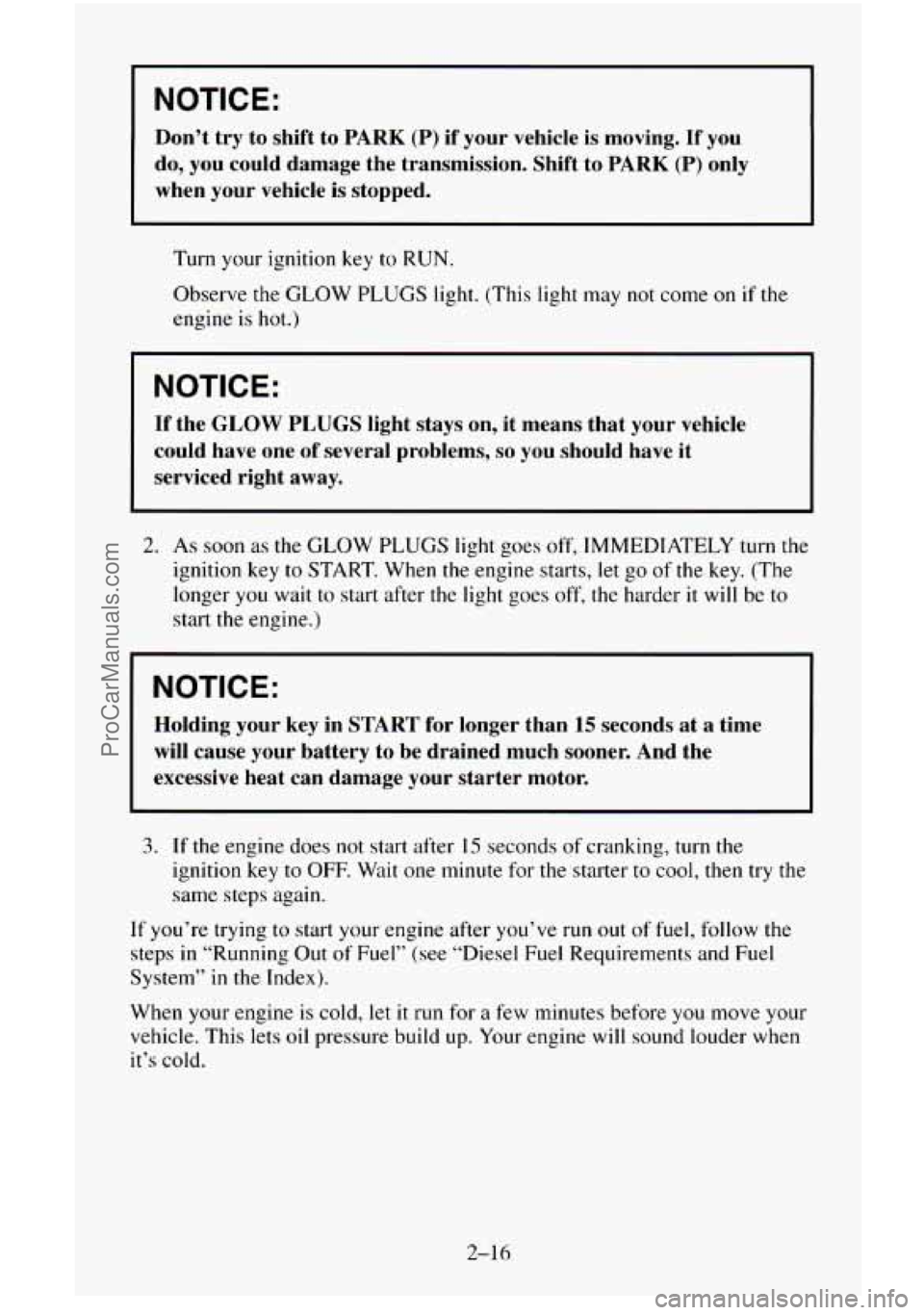
NOTICE:
Don’t try to shift to PARK (P) if your vehicle is moving. If you
do, you could damage the transmission. Shift to PARK
(P) only
when your vehicle is stopped.
Turn your ignition
key to RUN.
Observe the GLOW PLUGS light. (This light may not come on if the
engine is hot.)
NOTICE:
If the GLOW PLUGS light stays on, it means that your vehicle
could have one
of several problems, so you should have it
serviced right
away.
2. As soon as the GLOW PLUGS light goes off, IMMEDIATELY turn the
ignition key to START. When the engine starts, let go of the key. (The
longer you wait to start after the light goes off, the harder it will be to
start the engine.)
NOTICE:
Holding your key in START for longer than 15 seconds at a time
will cause your battery to be drained much sooner. And the
excessive heat can damage your starter motor.
3. If the engine does not start after 15 seconds of cranking, turn the
ignition key
to OFF. Wait one minute for the starter to cool, then try the
same steps again.
If you’re trying to start your engine after you’ve run out of fuel, follow the
steps
in “Running Out of Fuel” (see “Diesel Fuel Requirements and Fuel
System”
in the Index).
When your engine is cold, let it
run for a few minutes before you move your
vehicle. This lets oil pressure build up. Your engine will sound louder when
it’s cold.
2-16
ProCarManuals.com